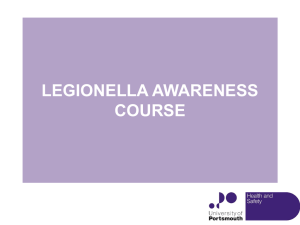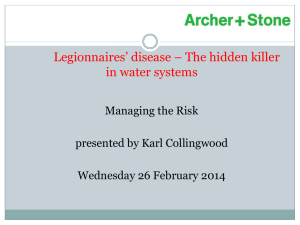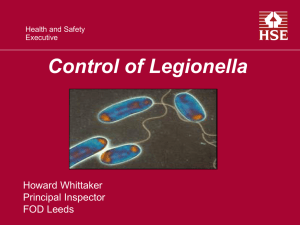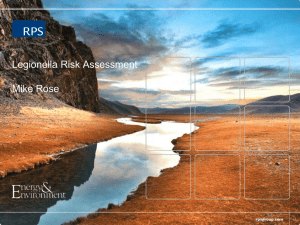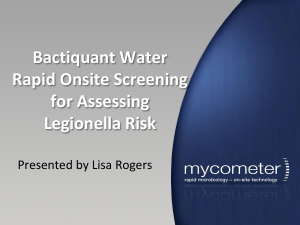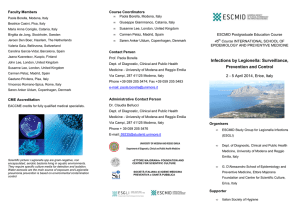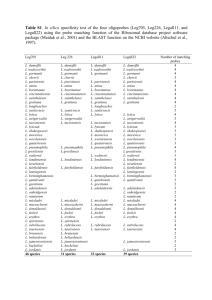Risk Management Plan for Legionella Control
advertisement
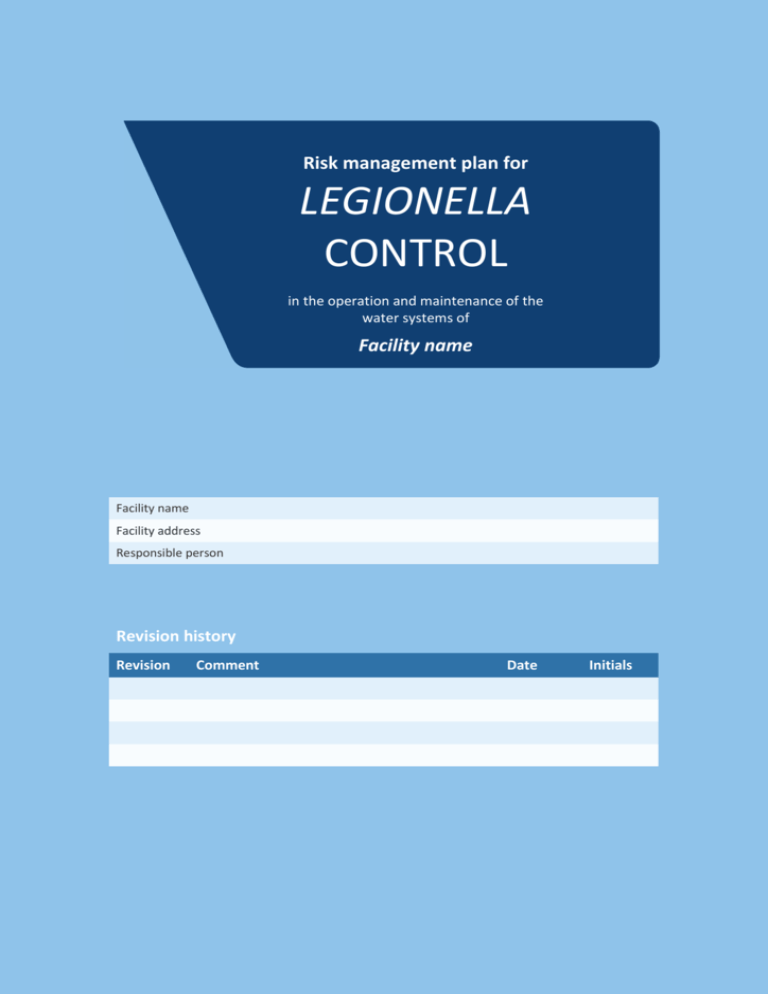
Risk management plan for LEGIONELLA CONTROL in the operation and maintenance of the water systems of Facility name Facility name Facility address Responsible person Revision history Revision 1 Comment Date Risk management plan for Legionella control for (FACILITY NAME) Initials Contents 1 Risk management team.................................................................................................... 1 2 Risk analysis .................................................................................................................... 2 3 4 4 2.1 System description ....................................................................................................... 2 2.2 Hazard identification and risk assessment ................................................................... 6 Risk management .......................................................................................................... 10 3.1 Control procedures .................................................................................................... 10 3.2 Monitoring.................................................................................................................. 11 Responding to detections or cases .................................................................................. 15 4.1 Key incident response people and their responsibilities ........................................... 15 4.2 Response procedures ................................................................................................. 15 Review of plan ............................................................................................................... 17 Appendix ................................................................................................................................... 18 Key contacts ............................................................................................................................ 18 Key documents ........................................................................................................................ 18 Advisory note This template has been provided to assist in the development of a risk management plan for Legionella control based on the information and processes described in the enHealth Guidelines for Legionella control in the operation and maintenance of drinking water distribution systems in health and aged care facilities. Advisory information has been included in certain sections to assist with the interpretation and completion of relevant plan details. It is expected that this content will be either deleted or replaced with content specific to your facility in your final document. In the event of complicated plumbing infrastructure, positive Legionella test results that are not easily controlled via the implementation of measures within the plan, an outbreak of Legionnaires’ disease, or lack of confidence in in-house ability to prepare the plan, external expert assistance should be sought. i Risk management plan for Legionella control for (FACILITY NAME) 1 Risk management team Summary of actions: • • • Nominate Legionella risk management team members. Record why team members have been selected to participate in Legionella risk management. Clearly articulate the responsibilities of each member of the risk management team. Table 1 Risk management team members Name 1 Organisation Position Legionella risk management responsibilities Risk management plan for Legionella control for (FACILITY NAME) Skills/knowledge/experience (reasons for being in team) Contact details 2 Risk analysis Summary of actions: • • • • • • • Gather information on the water supply system. Gather information on the water uses and users within the facility. Describe the system (including treatment). Discuss the quality of incoming water. Identify hazards associated the facility’s water supply system. Identify existing control measures. Perform risk assessment. 2.1 System description Insert a flow diagram/schematic drawing/plan of your facility’s system. An example is shown below. Backflow prevention Incoming Water from XXX Council Rainwater tanks Backflow prevention CHLORINATION Ice machine Fire fighting Cold Water Storage Cold Water Storage Laundry & Kitchen Showers & wash basins in Wards 1 -5, maternity (and birthing pools), ICU and foyer. Water dispenser – foyer, dental suite Showers & wash basins in Wards 1 -3 and maternity ward (including birthing pools) Air cooling Water Heater Water Heater TMVs TMVs Showers & wash basins in Ward 4 and dental suite Water Heater TMVs Showers & wash basins in Ward 5 and ICU Figure 1 Schematic of Facility name water delivery system 2 Risk management plan for Legionella control for (FACILITY NAME) irrigation 2.1.1 Uses of water List uses of water within the facility, for example: • • • • • • • • • • • • drinking (includes feed into ice machines and water dispensers) clinical uses (e.g. dialysis, hydrotherapy, dental chairs) swimming and spa pools bathing toilet flushing laundry firefighting and fire suppression (including sprinklers) air conditioning food preparation (including ice making) irrigation of grounds birthing pools decorative fountains. 2.1.2 Users of water Provide details of water users in the facility, for example: • • • • facility population/number of beds clinical functions (e.g. maternity, intensive care etc) specialist functions (e.g. dental) approximate percentage and location (if possible) of high and low clinical risk patients. 2.1.3 Incoming water Provide details of incoming water, both potable and non-potable. If there are various sources, identify the linked uses (see 2.1.1). For example: • • • • • • What is the source of the incoming water (e.g. bore, surface, rainwater)? What treatment processes does the incoming water undergo before entry into facility? Where are the entry points for the incoming to the facility? How reliable is the incoming water? Is the water treated within your facility? Is there an emergency supply and what is its source and quality? 2.1.4 Quality of incoming water Describe the typical water quality characteristics of the incoming water. Parameters to consider are disinfection residual in the water entering the facility, temperature, pH, turbidity, water chemistry, metals and bacteriological quality. 2.1.5 System details Provide overview of water system, for example: • • 3 Incoming water is supplied to a water heater of xxx litres capacity, set at xx degrees C. Water within the system is treated using xxx (e.g. copper silver ionisation) Risk management plan for Legionella control for (FACILITY NAME) • • 4 Heated water is supplied to outlets in two ICU rooms and 5 general wards. Outlets consist of showers, baths, wash basins and sinks. Each outlet has a TMV with the maximum distance between heater and TMV of xxx metres. Guidelines for Legionella control Table 2 Inventory of system components (edit, add or delete rows as required) System component Characteristic Hot water heaters Number, location, capacity Type of heating Details e.g. solar, gas, instant Max. temperature Age of heaters Capacity Cold water storages Number, location, capacity Capacity Water treatment Pipework Material e.g. concrete, steel, plastic Water age (i.e. time since disinfection) If known Type, location e.g. chlorine disinfection Dose rate (if chemical treatment) e.g. 1 mg/L Target residual at most distal point in water system (if chemical treatment) e.g. 0.5 mg/L Age Material Type and extent of insulation Number of dead legs and locations Areas of low flow % of pipework that is accessible Outlets TMVs and tempering valves Number, type and location of hot water outlets e.g. 5 sinks in kitchen Number, type and location of cold water outlets e.g. 8 taps in landscaped garden Number, type and location of warm water outlets e.g. 35 showers in maternity unit Type, number, age and location Include date of last service Distance from outlets Accessibility Maximum temperature at outlet Other components that use water Hydrotherapy baths, birthing pools Humidifiers Water dispensing machine 5 Risk management plan for Legionella control for (FACILITY NAME) System component Characteristic Details Ice machines Cooling towers Rainwater tanks Fire protection system RPZ – backflow prevention Number and location 2.2 Hazard identification and risk assessment 2.2.1 Hazard identification Identify the hazards and potential hazardous events that could affect the water quality within the described water supply system, promoting Legionella colonisation and growth, along with their corresponding control measures. The table below lists some examples of potential hazardous events commonly associated with a facility’s water system. Table 3 Examples of potential hazardous events System component Event Incoming water Incoming water contamination Loss of supply Failure of backflow prevention device Solar preheat systems Water stored at below 60°C Hot water storage Heater failure or under capacity Booster failure Build-up of sludge in tank Thermal stratification Storage temperature too low (below 60 °C) Cold water storage Water stagnation Contamination of storage tank Build-up of sludge in tank Water temperature >20 °C Pipework/plumbing Dead legs and capped pipes Cross connections between potable and non-potable pipes Deterioration of insulation (lagging) around pipes TMV malfunction or inadequate maintenance Long distances between TMVs or tempering valves and outlets 6 Guidelines for Legionella control System component Event Corrosion due to deterioration of materials Pipe leaks due to age Heating of cold water in pipes (>20 °C) Low flow in recirculating loops Lack of accessibility for repairs and maintenance Outlets Poorly maintained outlets Unused outlets Flow restrictors Aerators Outlets that hold water after use (e.g. shower heads or hoses) Treatment systems Dosing failure Insufficient dosing Running out of disinfectant 2.2.2 Risk assessment This section includes qualitative measures of likelihood and consequence to allow you to calculate the level of risk for different potential adverse outcomes in your facility. Remember that some controls will be insufficient in themselves to get the level of risk down to low, so keep adding controls until the risk is acceptable. Table 4a Qualitative measures of likelihood Level Descriptor Example description A Almost certain Is expected to occur in most circumstances B Likely Will probably occur in most circumstances C Possible Might occur or should occur at some time D Unlikely Could occur at some time E Rare May occur only in exceptional circumstances 7 Risk management plan for Legionella control for (FACILITY NAME) Table 4b Qualitative measures of consequence or impact on facility Level Descriptor Example description 1 Insignificant Insignificant impact, little disruption to normal operation, low increase in normal operating costs (e.g. temporary low chlorine residual that can be resolved via increased flushing) 2 Minor Minor impact for part of facility, some manageable disruption to normal operation, some increase in operating costs (e.g. several rooms or one wing with total bacterial count >500 CFU/mL, requiring more frequent flushing to maintain chlorine residuals) 3 Moderate Minor impact for most of facility, significant but manageable modification to normal operation, increase in operating costs, increased monitoring (e.g. extensive bacterial growth with some Legionella, requiring extensive flushing and additional controls) 4 Major Major impact for part of facility, systems significantly compromised, abnormal (if any) operation, high level of monitoring required (e.g. temporary closure of part of facility requiring extensive disinfection) 5 Catastrophic Major impact for whole of facility, complete failure of systems (e.g. extensive Legionella colonisation, with possible cases of Legionnaires’ disease) Table 4c Qualitative risk analysis matrix – level of risk Likelihood Consequences 1 Insignificant 2 Minor 3 Moderate 4 Major 5 Catastrophic A (almost certain) Moderate High Very high Very high Very high B (likely) Moderate High High Very high Very high C (possible) Low Moderate High Very high Very high D (unlikely) Low Low Moderate High Very high E (rare) Low Low Moderate High High 8 Guidelines for Legionella control Table 5 Hazard identification and risk assessment table, including examples (edit and add rows as required) System component Hazard and hazardous event Risk score Possible control measures Incoming water Supply of water with low chlorine residual Medium Install onsite chlorination to achieve 0.5 mg/L at all high risk outlets Incoming water Supply of microbiologically contaminated water Medium Agreement with water supplier to notify facility manager of any bacteriological contamination; increase chlorine dose chlorinator; flush out contaminated water Hot water system Water temperature too low (to inhibit growth of Legionella and other opportunistic pathogens) Medium Measure temperature daily and adjust if too low Warm water system Distance from TMV to outlet > 6 m leading to Legionella detections in high risk location High Move TMV closer to outlet or install point of use filter on outlet Pipework Low flow in several areas (allows adherence and proliferation of Legionella and other opportunistic pathogens) High Weekly flushing of water in areas of low use 9 Risk management plan for Legionella control for (FACILITY NAME) 3 Risk management Summary of actions: • • • • • • Identify and implement control measures for management of risks. Establish an operational monitoring program. Develop written procedures for required actions. Determine and implement corrective actions for exceedance of critical operational limits. Establish a verification monitoring program. Determine and implement responses to exceedances of limits in the verification monitoring program. 3.1 Control procedures All control measures and monitoring activities, whether they are regular maintenance, operational practices or corrective actions, require written procedures detailing how to undertake the required tasks. Complete the table below with control measures identified in the hazard identification and risk assessment table and operational procedure. Table 6 Risk management plan procedures (edit, add or delete rows as required) System component Control measure Procedure e.g. pipework Regular (weekly) flushing of low use areas e.g. MTS xxxx Flushing of pipes in Ward 2 e.g. treatment Changing dose rate of disinfectant e.g. OPS xxxx Adjustment of chlorine dose e.g. outlet — TMV Regular maintenance of TMV e.g. MTS xxxx Cleaning of TMV and thermal disinfection of all pipework and outlets downstream of TMV - yearly e.g. outlets Collecting warm water samples for Legionella testing e.g. SP xxxx Sample collection for Legionella – Warm water AND e.g. SP xxx – sample storage and transportation to City Laboratory 10 Guidelines for Legionella control 3.2 Monitoring 3.2.1 Operational monitoring Many control measures that manage risk in the water supply are in fact corrective actions to measured parameters at particular frequencies and locations when such parameters exceed a critical limit. Populate the table below with all the operational (i.e. ‘real time’) monitoring undertaken in the facility. 11 Risk management plan for Legionella control for (FACILITY NAME) Table 7 Operational monitoring, showing examples (edit, add or delete rows as required) System component Risk Incoming water Low disinfectant residual Chlorine residual Online or weekly Point of entry into facility Hot Water Low temperature Temperature Weekly Warm water Water temperature that supports Legionella growth Temperature Daily 12 Parameter Guidelines for Legionella control Frequency Location Critical limit Record Corrective action (where is the measurement recorded) (all corrective actions listed here should have a procedure listed in Table 6) Less than 0.5 mg/L Chlorine residual record sheet CR 1.001 Increase chlorine dose within facility Hot water Outlet in kitchen (sink tap at far right corner) Temperature less than 65 °C Weekly temperature kitchen record sheet TP 4.333 Increase temperature of water heater Outlet furthest from water heater (wash basin tap in room xx) Temperature greater than 20 °C and less than 50 °C Daily temperature – ward 2 record sheet Check heater temperature and adjust if required, check pipework for loss of heat, check operation of TMV TP 1.333 3.2.2 Verification monitoring and responses Verification monitoring involves the taking of samples for analysis of a particular parameter. The results of the samples confirm that control measures are effective and water quality risk is being managed. All verification monitoring results that are outside quality standards or critical limits, and confirmed cases of Legionellosis, require responses. Populate the table below with all the verification monitoring undertaken in the facility. 13 Risk management plan for Legionella control for (FACILITY NAME) Table 8 Verification monitoring, showing examples (edit, add or delete rows as required) Parameter Frequency Location Limit Reported to Operational response to exceedance of critical limit (all responses should have a Clinical response to exceedance of limit procedure as per Table 6) (all responses should have a procedure listed as per Table 6) Heterotrophic plate count Monthly Distal warm water taps — wash basins in rooms xxx Greater than 500 CFU/mL Building, engineering and maintenance services (BEMS) supervisor 1. Check operational measurements (temperature, pH, turbidity, disinfectant residuals and dose), maintenance schedules (including flushing regimes) and structural integrity 2. Flush water through until sufficient disinfectant residual is achieved at sampling point 3. Resample after responses are completed None Legionella spp. Quarterly Distal warm water taps – wash basins in room with low risk patients Greater than 10 CFU/100 mL BEMS manager and CEO 1. Check operational measurements, maintenance schedules and structural integrity of system 2. Clean and sanitise TMV and outlet fitting Remove patient/s from affected room Distal warm water taps — wash basins in room with high risk patients Greater than 10 CFU/mL Legionella spp. 14 Quarterly Guidelines for Legionella control 3. If resample positive, move to next row BEMS manager and CEO 1. Check operational measurements, maintenance schedules and structural integrity of system 2. Clean and sanitise TMV and outlet fitting 3. Clean pipework 4. Superchlorinate system Remove patient/s from affected room 4 Responding to detections or cases Summary of actions: • • • Identify measures for responding to Legionella detections and cases in various scenarios. Identify key people and their responsibilities and authorities when responding to detections or cases. Develop written procedures for required actions. 4.1 Key incident response people and their responsibilities In an incident situation, the risk management team will meet to assess the available information and direct the appropriate responses. The following people will be required to direct those responses and ensure they are undertaken in accordance with documented procedures. Table 9 Incident response key personnel and their responsibilities (edit, add or delete rows as required) Response Responsible person Contact information e.g. water sampling / system investigation e.g. coordinating system decontamination e.g. high risk patient identification e.g. implementation of high risk patient protection procedures e.g. media liaison 4.2 Response procedures Response activities, whether they are investigations, remedial action or stakeholder liaisons, require written procedures detailing how to undertake the required tasks. Complete the table below that matches responses identified in the incident response measure identification process. Some of these responses will be sequential and will require information obtained following the implementation of other proceeding procedures. It may also be useful to prepare flow charts showing the sequence of actions required in various incident scenarios. 15 Risk management plan for Legionella control for (FACILITY NAME) Table 10 Incident response procedures (edit, add or delete rows as required) Incident Responses Procedure name e.g. isolated Legionella species detection Water sampling or system evaluation e.g. INV xxxx Undertaking a Legionella colonisation investigation e.g. isolated Legionella species detection Localised partial system decontamination e.g. INC xxxx Assess and undertake appropriate local partial system decontamination e.g. single confirmed Legionnaires’ disease case linked to facility Case activity investigation e.g. INC xxxx Assess potential case exposures during incubation period e.g. single confirmed Legionnaires’ disease case linked to facility High risk patient identification e.g. INV xxxx Undertaking a high risk patient identification e.g. single confirmed Legionnaires’ disease case linked to facility Implementation of high risk patient protection procedures e.g. INC xxxx Protecting identified high risk patients 16 Guidelines for Legionella control 4 Review of plan Summary of actions: • • Prepare a schedule for review of the plan. List reasons for updating of plan. A full review of the plan will be conducted on a XXXX basis. The plan will be reviewed more frequently as a result of: • 17 List reasons: (e.g. change in infrastructure, detection of Legionella, new staff or roles, changes in legislation or standards etc) Risk management plan for Legionella control for (FACILITY NAME) Appendix Key contacts List key contacts for the plan including risk management team members, laboratory testing, equipment suppliers or service agents, local public health units etc. Key documents List key documents for reference, such as national guidelines, state/territory legislation, procedures etc. 18 Guidelines for Legionella control
